Kardi Teknomo
Determination of Pedestrian Flow Performance Based on Video Tracking and Microscopic Simulations
Sep 08, 2016


Abstract:One of the objectives of understanding pedestrian behavior is to predict the effect of proposed changes in the design or evaluation of pedestrian facilities. We want to know the impact to the user of the facilities, as the design of the facilities change. That impact was traditionally evaluated by level of service standards. Another design criterion to measure the impact of design change is measured by the pedestrian flow performance index. This paper describes the determination of pedestrian flow performance based video tracking or any microscopic pedestrian simulation models. Most of pedestrian researches have been done on a macroscopic level, which is an aggregation of all pedestrian movement in pedestrian areas into flow, average speed and area module. Macroscopic level, however, does not consider the interaction between pedestrians. It is also not well suited for prediction of pedestrian flow performance in pedestrian areas or in buildings with some obstruction, that reduces the effective width of the walkways. On the other hand, the microscopic level has a more general usage and considers detail in the design. More efficient pedestrian flow can even be reached with less space. Those results have rejected the linearity assumption of space and flow in the macroscopic level.
Tracking System to Automate Data Collection of Microscopic Pedestrian Traffic Flow
Sep 07, 2016


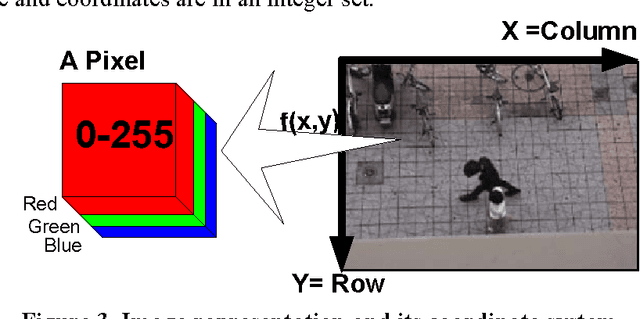
Abstract:To deal with many pedestrian data, automatic data collection is needed. This paper describes how to automate the microscopic pedestrian flow data collection from video files. The study is restricted only to pedestrians without considering vehicular - pedestrian interaction. Pedestrian tracking system consists of three sub-systems, which calculates the image processing, object tracking and traffic flow variables. The system receives input of stacks of images and parameters. The first sub-system performs Image Processing analysis while the second sub-system carries out the tracking of pedestrians by matching the features and tracing the pedestrian numbers frame by frame. The last sub-system deals with a NTXY database to calculate the pedestrian traffic-flow characteristic such as flow rate, speed and area module. Comparison with manual data collection method confirmed that the procedures described have significant potential to automate the data collection of both microscopic and macroscopic pedestrian flow variables.
Tracking Algorithm for Microscopic Flow Data Collection
Sep 07, 2016Abstract:Various methods to automate traffic data collection have recently been developed by many researchers. A macroscopic data collection through image processing has been proposed. For microscopic traffic flow data, such as individual speed and time or distance headway, tracking of individual movement is needed. The tracking algorithms for pedestrian or vehicle have been developed to trace the movement of one or two pedestrians based on sign pattern, and feature detection. No research has been done to track many pedestrians or vehicles at once. This paper describes a new and fast algorithm to track the movement of many individual vehicles or pedestrians
Automation of Pedestrian Tracking in a Crowded Situation
Sep 06, 2016


Abstract:Studies on microscopic pedestrian requires large amounts of trajectory data from real-world pedestrian crowds. Such data collection, if done manually, needs tremendous effort and is very time consuming. Though many studies have asserted the possibility of automating this task using video cameras, we found that only a few have demonstrated good performance in very crowded situations or from a top-angled view scene. This paper deals with tracking pedestrian crowd under heavy occlusions from an angular scene. Our automated tracking system consists of two modules that perform sequentially. The first module detects moving objects as blobs. The second module is a tracking system. We employ probability distribution from the detection of each pedestrian and use Bayesian update to track the next position. The result of such tracking is a database of pedestrian trajectories over time and space. With certain prior information, we showed that the system can track a large number of people under occlusion and clutter scene.
Comparison of several short-term traffic speed forecasting models
Sep 06, 2016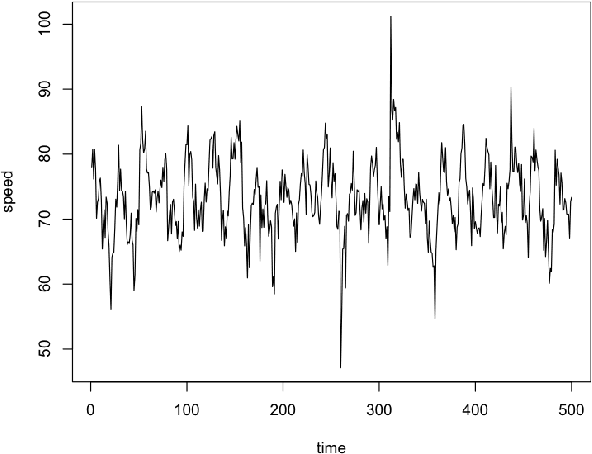
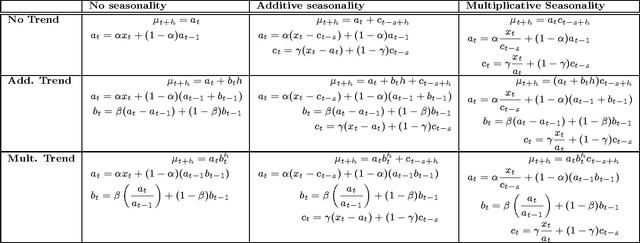
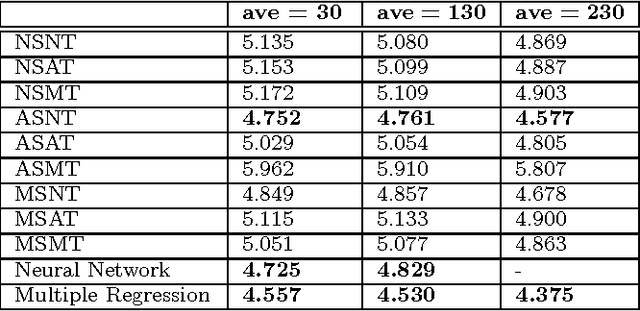
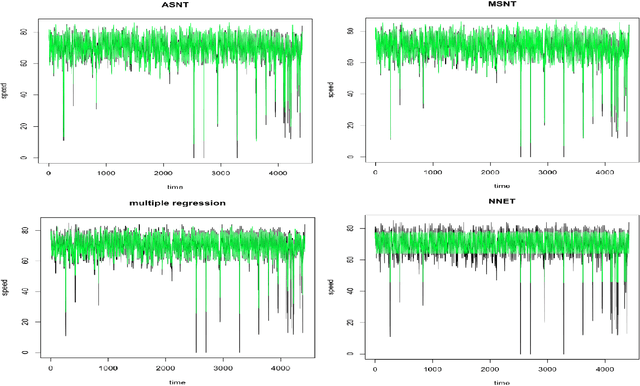
Abstract:The widespread adoption of smartphones in recent years has made it possible for us to collect large amounts of traffic data. Special software installed on the phones of drivers allow us to gather GPS trajectories of their vehicles on the road network. In this paper, we simulate the trajectories of multiple agents on a road network and use various models to forecast the short-term traffic speed of various links. Our results show that traditional techniques like multiple regression and artificial neural networks work well but simpler adaptive models that do not require prior training also perform comparatively well.
Multi Exit Configuration of Mesoscopic Pedestrian Simulation
Sep 06, 2016



Abstract:A mesoscopic approach to modeling pedestrian simulation with multiple exits is proposed in this paper. A floor field based on Qlearning Algorithm is used. Attractiveness of exits to pedestrian typically is based on shortest path. However, several factors may influence pedestrian choice of exits. Scenarios with multiple exits are presented and effect of Q-learning rewards system on navigation is investigated
OpenTripPlanner, OpenStreetMap, General Transit Feed Specification: Tools for Disaster Relief and Recovery
Sep 06, 2016



Abstract:Open Trip Planner was identified as the most promising open source multi-modal trip planning software. Open Street Map, which provides mapping data to Open Trip Planner, is one of the most well-known open source international repository of geographic data. General Transit Feed Specification, which provides transportation data to Open Trip Planner, has been the standard for describing transit systems and platform for numerous applications. Together, when used to implement an instance of Open Trip Planner, these software has been helping in traffic decongestion all over the world by assisting commuters to shift from using private transportation modes to public ones. Their potential however goes beyond providing multi-modal public transportation routes. This paper aims to first discuss the researchers' experience in implementing a public transportation route planner for the purpose of traffic decongestion.The researchers would examine the prospective of using the system for disaster preparedness and recovery and concrete ways on how to realize them.
Q-Learning with Basic Emotions
Sep 06, 2016



Abstract:Q-learning is a simple and powerful tool in solving dynamic problems where environments are unknown. It uses a balance of exploration and exploitation to find an optimal solution to the problem. In this paper, we propose using four basic emotions: joy, sadness, fear, and anger to influence a Qlearning agent. Simulations show that the proposed affective agent requires lesser number of steps to find the optimal path. We found when affective agent finds the optimal path, the ratio between exploration to exploitation gradually decreases, indicating lower total step count in the long run
Microscopic Pedestrian Flow Characteristics: Development of an Image Processing Data Collection and Simulation Model
Sep 06, 2016



Abstract:Microscopic pedestrian studies consider detailed interaction of pedestrians to control their movement in pedestrian traffic flow. The tools to collect the microscopic data and to analyze microscopic pedestrian flow are still very much in its infancy. The microscopic pedestrian flow characteristics need to be understood. Manual, semi manual and automatic image processing data collection systems were developed. It was found that the microscopic speed resemble a normal distribution with a mean of 1.38 m/second and standard deviation of 0.37 m/second. The acceleration distribution also bear a resemblance to the normal distribution with an average of 0.68 m/ square second. A physical based microscopic pedestrian simulation model was also developed. Both Microscopic Video Data Collection and Microscopic Pedestrian Simulation Model generate a database called NTXY database. The formulations of the flow performance or microscopic pedestrian characteristics are explained. Sensitivity of the simulation and relationship between the flow performances are described. Validation of the simulation using real world data is then explained through the comparison between average instantaneous speed distributions of the real world data with the result of the simulations. The simulation model is then applied for some experiments on a hypothetical situation to gain more understanding of pedestrian behavior in one way and two way situations, to know the behavior of the system if the number of elderly pedestrian increases and to evaluate a policy of lane-like segregation toward pedestrian crossing and inspects the performance of the crossing. It was revealed that the microscopic pedestrian studies have been successfully applied to give more understanding to the behavior of microscopic pedestrians flow, predict the theoretical and practical situation and evaluate some design policies before its implementation.
Background Image Generation Using Boolean Operations
Oct 04, 2015



Abstract:Tracking moving objects from a video sequence requires segmentation of these objects from the background image. However, getting the actual background image automatically without object detection and using only the video is difficult. In this paper, we describe a novel algorithm that generates background from real world images without foreground detection. The algorithm assumes that the background image is shown in the majority of the video. Given this simple assumption, the method described in this paper is able to accurately generate, with high probability, the background image from a video using only a small number of binary operations.
 Add to Chrome
Add to Chrome Add to Firefox
Add to Firefox Add to Edge
Add to Edge